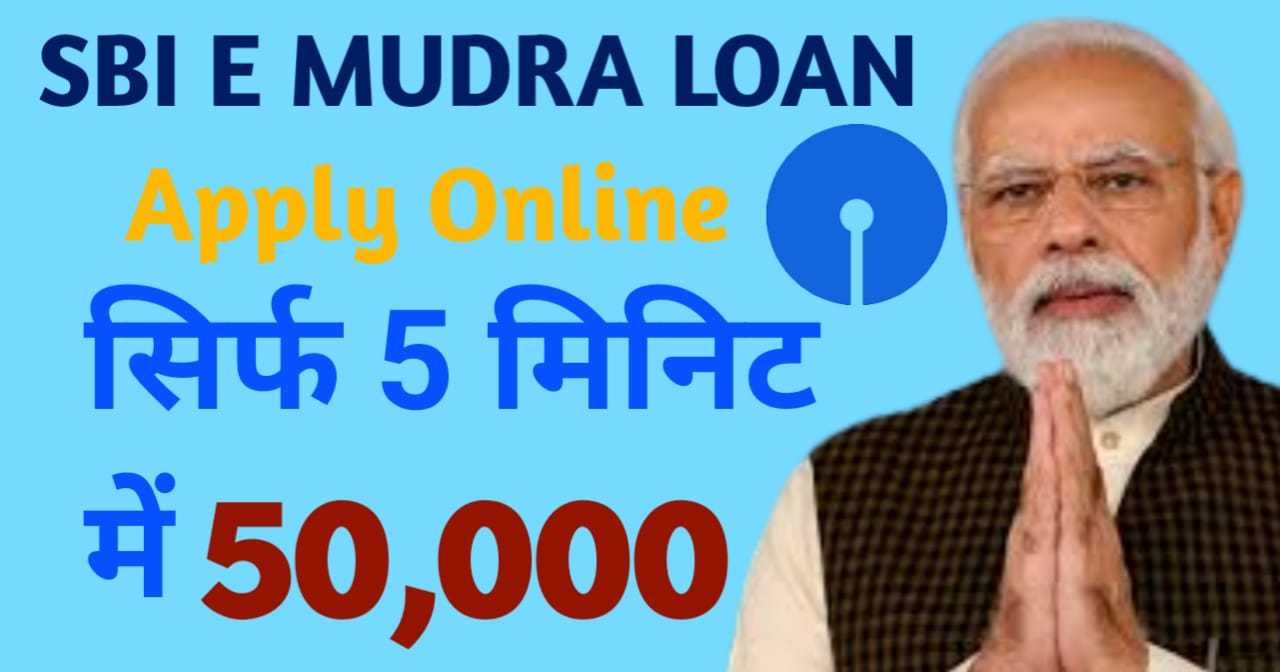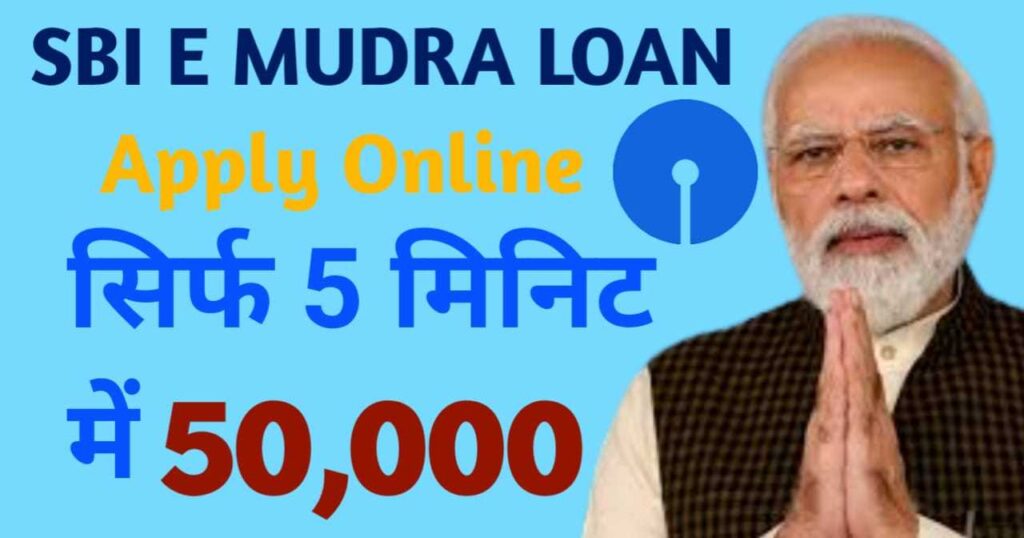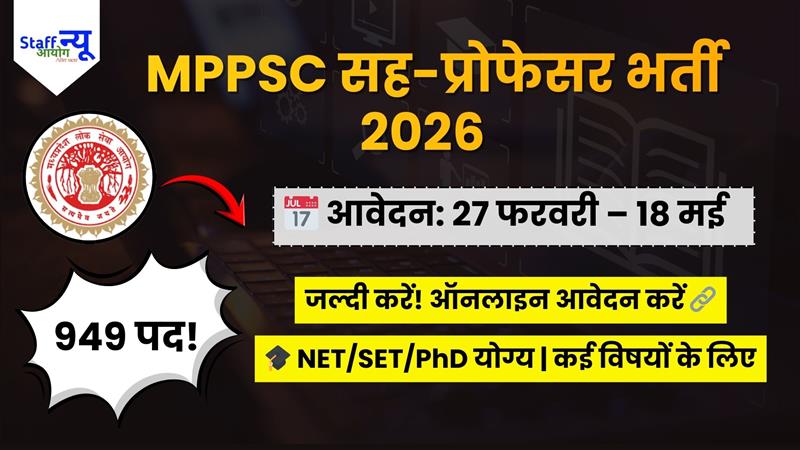- Home
- SBI E Mudra Loan Apply online 2023 Documents, Eligibility, Form

SBI E Mudra Loan Apply online 2023 Documents, Eligibility, Form
If you’re interested in SBI E Mudra Loan Apply in 2023, you can find all the necessary information on this page. State Bank of India is offering loans for both personal and business needs, including PM Mudra Yojana. To learn more about the procedure, eligibility, required documents, and the online application form keep reading this article.
SBI e-Mudra loan is a loan provided by the State Bank of India (SBI) under the Mudra scheme for small and micro businesses in India. This blog will provide a quick overview of the SBI e-Mudra loans, including eligibility criteria, loan amount, interest rate, repayment tenure, and the application process.
SBI E Mudra Loan 2023
SBI E Mudra Loan is a type of loan offered by the State Bank of India (SBI) under the government’s Mudra (Micro Units Development and Refinance Agency) scheme. This loan is designed to provide financial assistance to micro and small enterprises in the manufacturing, trading, and services sectors

The SBI E Mudra Loan can be availed in both secured and unsecured forms. The loan amount ranges from Rs. 50,000 to Rs. 10 lakhs, and the repayment tenure can vary from 12 to 60 months.
To apply for an e-Mudra loan, you need to have a business plan, valid identity proof, and other relevant documents. You can apply for the loan online through SBI’s official website or by visiting the nearest SBI branch.
SBI E Mudra Loan 2023 Apply Online
The interest rate for the e-Mudra loan is competitive and can vary based on the loan amount, repayment tenure, and other factors. SBI also offers various other benefits and features like easy repayment options, flexible loan terms, and quick disbursal of funds to make the loan application process hassle-free.
Online Apply Step by Step
- Visit the official website of the State Bank of India (SBI) and click on the “Loans” tab.
- Under “Loans,” click on “Mudra Loans” and select “e-Mudra” from the drop-down menu.
- Read through the eligibility criteria and required documents carefully to ensure that you meet the criteria.
- Click on the “Apply Now” button and fill in the application form with all the required details, such as personal and business information, loan amount, and tenure.
- Upload the necessary documents, such as identity proof, address proof, bank statements, and business proof.
- Review your application form and submit it.
- After submitting the application, you will receive an acknowledgment from SBI with a reference number.
- The bank will review your application and, if approved, disburse the loan amount to your bank account.
- Note: It’s important to provide accurate information and all necessary documents while filling out the application form to avoid any delays or rejections in the loan approval process.
Loan amount of E mudra Loan
The loan amount for an SBI E Mudra Loan can range from Rs. 50,000 to Rs. 10 lakhs, depending on the nature and size of your business. You can apply for a secured or unsecured loan, depending on your preference and the collateral you can provide.
E Mudra Loan Eligibility
SBI E Mudra Loans are a great option for individuals looking to start a new business or expand their existing one. These loans are available to non-cooperative small businesses (NCBS) in both urban and rural segments. NCBS includes a wide range of businesses such as small manufacturing units, service sector units, shopkeepers, fruit and vegetable vendors, food service units, repair shops, machine operators, small industries, and more.
To avail Mudra loan under the Shishu category, which is specifically for startups, applicants must present a viable business idea along with a profit-making model. The maximum loan amount that can be availed under this category is Rs. 50,000.
Already established businesses or newly established ones can apply for Mudra loans under the Kishore or Tarun schemes. These loans can be used to expand the business by upgrading machinery and equipment.
SBI E MUDRA scheme explained in tabular form
| Aspect | Details |
|---|---|
| Name of Scheme | SBI E MUDRA Scheme |
| Purpose | To provide financial assistance to small businesses and startups |
| Eligibility Criteria | NCBS (Non-Corporate Small Business) in rural and urban areas |
| Loan Categories | Shishu, Kishore, and Tarun |
| Shishu Category | For startups, up to Rs. 50,000 loan amount |
| Kishore Category | For established businesses, between Rs. 50,000 and Rs. 5 lakhs |
| Tarun Category | For businesses requiring higher loan amounts, between Rs. 5 lakhs and Rs. 10 lakhs |
| Interest Rate | As per SBI’s prevailing interest rates for loans |
| Repayment Period | Up to 5 years for Kishore and Tarun categories, up to 3 years for the Shishu category |
| Collateral | Collateral-free loans provided to eligible applicants |
| Application Process | Online application process through SBI’s website |
| Required Documents | ID proof, address proof, bank statements, business proof, etc. |
Benefits of SBI E MUDRA loan
The loan limit for Mudra loans depends on the category under which the applicant applies. Here are the loan limits for each category:
- Shishu: This category is for startups and the loan limit is up to Rs. 50,000.
- Kishore: This category is for businesses that are already established and the loan limit is between Rs. 50,000 and Rs. 5 lakhs.
- Tarun: This category is for businesses that require a higher loan amount for expansion and the loan limit is between Rs. 5 lakhs and Rs. 10 lakhs.
E Mudra Loan Application process
You can apply for an SBI e-Mudra loan online through SBI’s official website or by visiting the nearest SBI branch. The loan application process is simple and straightforward, and you can get quick approval and disbursal of funds if you meet the eligibility criteria and submit all the required documents.
E Mudra Loan Documents
To apply for an SBI E MUDRA loan, the following documents are required:
- Identity proof such as an Aadhaar card, passport, driving license, voter ID card, PAN card, etc.
- Address proof such as an Aadhaar card, passport, driving license, voter ID card, utility bill, etc.
- Proof of business such as GST registration, partnership deed, sales tax registration, etc.
- Bank statement for the last 6 months.
- Proof of category such as SC/ST/OBC certificate (if applicable).
- Business plan/proposal for the loan amount requested.
Post Overview
| Post TItel | SBI E Mudra Loan Apply online |
| Category | Finance |
| Apply Online | Click Here |
| Home Page | sscnr.net.in |
FAQ
What is SBI e-Mudra Loan?
Who is eligible for SBI e-Mudra Loan?
What is the loan amount that can be availed under SBI e-Mudra Loan?
What is the repayment period for SBI e-Mudra Loan?
What is the interest rate charged for SBI e-Mudra Loan?
What documents are required to apply for SBI e-Mudra Loan?
How can one apply for SBI e-Mudra Loan?
Latest Update
Admit Card
Latest Job
Answer Key
SSC – Staff Selection Commission
Latest News
Recent Posts
Categories
- Admit Card
- AI and Technology
- Answer Key
- Application Form
- Banking Jobs
- Board Result
- BSF and Army
- BTSC
- Call Letter
- CBSE Update
- Counselling
- Cricket
- Current Affairs
- Cut Off
- Earning Courses
- Earning Tips
- Entertainment
- Events
- Exam
- Films
- Finance
- Flood
- Game
- Govt interview update
- Havaldar and Constable Bharti
- indian railways
- IPl 2023
- Latest Job
- live score
- Lottery Results
- Marit List
- Mobile
- Net worth
- News
- Notice
- NTPC Engineering jobs
- Panchang
- Police Bharti
- Quotes
- Recruitment
- Result
- Sample paper
- Sarkari Naukari
- Sarkari Yojana
- Schemes
- Selection
- SSC
- SSC Admit Card
- SSC Answer Key
- SSC Exam
- SSC Recruitment
- SSC Result
- SSC Syllabus
- SSCNR
- Stock Market
- Syllabus
- Teacher's Job
- Technology
- Topper List
- typing test
- University Result
- UPSC updates
- Work From Home Jobs
- world record





























